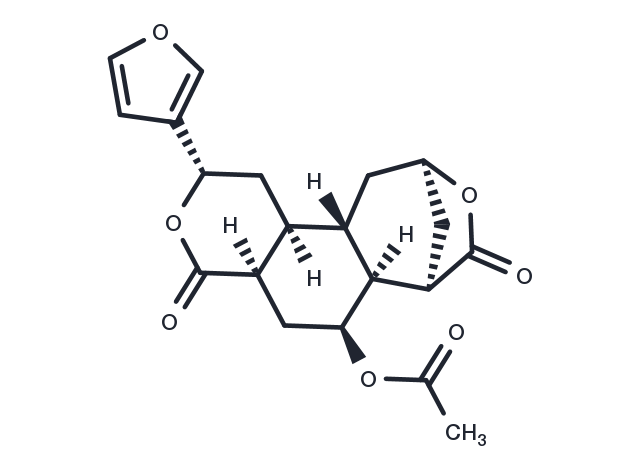Powder: -20°C for 3 years | In solvent: -80°C for 1 year


8-epidiosbulbin E acetate is an abundant diterpene lactone in Dioscorea bulbifera L. (DB), a traditional herbal medicine widely used in Asian countries.

| Description | 8-epidiosbulbin E acetate is an abundant diterpene lactone in Dioscorea bulbifera L. (DB), a traditional herbal medicine widely used in Asian countries. |
| In vitro | EEA-mediated R-plasmid curing decreased the minimal inhibitory concentration of antibiotics against MDR bacteria, thus making antibiotic treatment more effective. The antibiotic resistance patternrevealed that the compound was effective in the reversal of bacterial resistance to various antibiotics[1]. |
| In vivo | EEA exhibits time- and dose-dependent liver injury in mice.?Pretreatment with ketoconazole prevented the animals from developing EEA-induced liver injury, caused 7- and 13-fold increases in the plasma Cmax and AUC of EEA, and decreased urinary excretion of glutathione conjugates derived from EEA.?Pretreatment with buthionine sulfoximine exacerbated EEA-induced hepatotoxicity[2]. |
| Cell Research | The ?minimal inhibitory concentration and subinhibitory concentration ?of EEA were determined by the agar dilution method .?Pathogenic bacterial cultures were grown in the presence of EEA at specified concentrations for 24 h at 37℃ and then plated on Luria agar plates to obtain isolated colonies.?The isolated colonies were then replica plated onto Luria agar and Luria agar containing antibiotics.?Colonies that failed to grow in the presence of antibiotics were considered as putative cured derivatives.?Physical loss of the plasmid in the cured derivative was confirmed by agarose gel electrophoresis of the plasmid DNA preparation of respective cultures.?The percentage curing efficiency was expressed as the number of colonies with cured phenotype per 100 colonies tested.?The antibiotic resistance profiles of plasmid-harbouring strains and plasmid-cured strains were determined by the disc diffusion method .?The zone of growth inhibition around the antibiotic disc was measured in millimetres following incubation at 37℃ for 24 h. The cultures were interpreted as resistant, intermediate or sensitive[1] . |
| Animal Research | Mice had free access to food and water and were housed in a temperature-controlled (22 +— 4 ℃) facility with a 12 h dark/light cycle for at least 5 days before treatment. EEA and tetrahydro-EEA (100 mg) was individually suspended in 10 mL of corn oil. The animals were randomly divided into six groups, and each group contained four mice. One group was treated intraperitoneally with corn oil as the control, and the other groups were given EEA at dosages of 50, 75, 100, or 150 mg/kg, or tetrahydro-EEA (100 mg/kg), respectively. The animals were sacrificed 12, 24, 36, and 48 h after the treatment[2]. |
| Molecular Weight | 374.39 |
| Formula | C20H22O7 |
| CAS No. | 1092368-67-6 |
Powder: -20°C for 3 years | In solvent: -80°C for 1 year
You can also refer to dose conversion for different animals. More
bottom
Please see Inhibitor Handling Instructions for more frequently ask questions. Topics include: how to prepare stock solutions, how to store products, and cautions on cell-based assays & animal experiments, etc.
8-epidiosbulbin E acetate 1092368-67-6 Others 8epidiosbulbin E acetate 8 epidiosbulbin E acetate 8-epidiosbulbin E Acetate inhibitor inhibit
